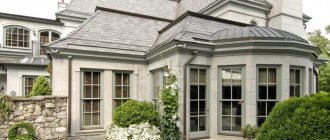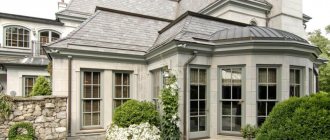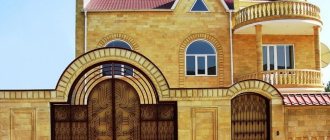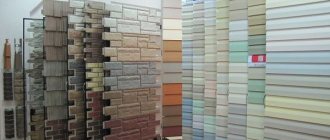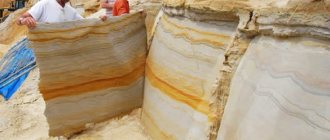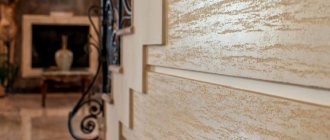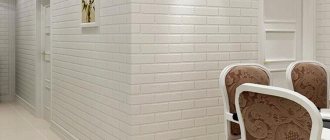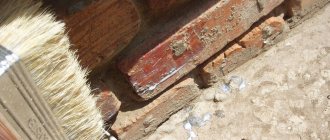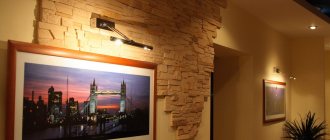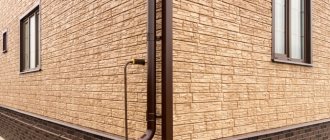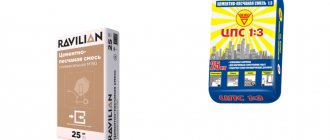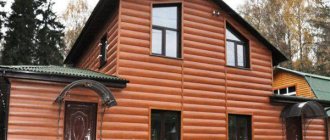Facade stone is an excellent alternative to hanging cladding coverings in the form of horizontal or vertical panels, and also significantly facilitates the task of ensuring the decorative appearance of the facade and the uniqueness of the structure.
Facade stone can be made from natural or artificial materials.
The range of stone colors for external cladding is varied: it can be of different types, which determines its color.
Since it is not always possible to make stone cladding, you can replace it with flexible stone.
This material is a fairly new facing coating; it perfectly reproduces the imitation of stone in any color scheme.
Description of flexible stone for facade
Stone for finishing the facade of a house in a flexible design is a modern facing coating that accurately imitates natural material. Visual resemblance to natural stone is ensured by the use of a stone cut in the manufacture of this canvas.
The technology for producing flexible plates involves manually cutting a thin layer of sandstone and applying it to a fiberglass or fabric base . The thickness of the stone layer of the canvas should be no more than three millimeters.
After the cut dries, the polymer base is separated from the stone coating, leaving a thin stone layer. The manual production of this facing coating contributes to its high price. Thanks to the use of natural raw materials, the natural texture on the outside of the canvas is preserved.
Plates or even canvases that are produced in this way can reach a length of up to 2.8 meters.
Photo of flexible stone:
Production nuances
A special feature of flexible stone manufacturing is that all processes are performed manually. At the same time, speed does not have a big impact on the final result. One person can make about 50 m2 of material in 8 hours. Therefore, an entrepreneur who does not have start-up capital can organize such a business with virtually no investment.
But if possible, then the best option would be to automate the process.
To do this you will need the following equipment:
- seeder for sandstone (sand, marble chips) – from 23,000 rubles;
- drying cabinets - from 45,000 rubles;
- device for cutting layers - from 95,000 rubles.
That is, the total amount spent on the purchase of equipment will be about 165,000 rubles. But despite the fact that the profitability of production is very high, all investments will pay off in a very short period of time.
Advantages and disadvantages of the material
An important feature of flexible stone is its ability to be mounted on any surface: a limited number of facade cladding materials are suitable for buildings with non-standard architecture, with rounded walls or rounded corners.
In this case, flexible stone is the ideal solution to provide decorative and reliable cladding.
In addition, the following parameters are the significant advantages of this type of cladding::
- flexibility . Thanks to this property, flexible stone slabs can be applied to any surface. Using a construction hair dryer for work, you can cover any bends at different angles with this material;
- ease . The material is very light and can be applied even to the thinnest walls. In this way, not only a beautiful design of the wall is ensured, but the surface is also somewhat strengthened;
- thermal stability . Due to this indicator, the material is not afraid of sunlight. Flexible stone is used for interior decoration even when decorating stoves and fireplaces;
- moisture resistance . The material prevents moisture accumulation due to its porous structure;
- decorativeness . A unique pattern is ensured by the random application of stone elements to the base. It is almost impossible to repeat the drawing. By adding various coloring pigments to the coating, not only brightness is ensured, but also the uniqueness of the design;
- environmental friendliness . Due to the inclusion of natural components in the structure of the material, its environmental friendliness is ensured: the material does not emit harmful elements and is not allergic;
- manufacturability and ease of installation. Slabs made of flexible stone are easy to cut with construction scissors, are flexible and lightweight, due to which installation can be done with one hand without special training or specific tools;
- preservation of properties over a wide range of temperature differences . Due to its heat resistance and relative frost resistance, the flexible material can be used in climatic regions where the air temperature can be from minus 40°C to +700°C;
- durability _ When properly used, the material can last more than 35 years. To increase service life, it is especially important to treat the coating with special protective agents in the form of impregnations.
Like any building material, flexible stone has its drawbacks. The main criterion for refusing to perform this type of cladding is its high cost. Since the manufacturing technology of this material is quite painstaking, this is reflected in the price.
Compared to natural stone, flexible coating has a short service life (while stone cladding can last more than 70 years).
Another point that does not always suit the consumer is the additional finishing of the coating . It will protect the material from external factors and extend its service life.
Errors when decorating premises
If stone finishing is planned in a small apartment, it is important not to overload the interior with too many complex shapes and colorful details, otherwise this will cause eye fatigue. You should carefully select the color and texture of the stone in accordance with other decoration and furniture.
Using different shades of stone, a room is often zoned, but in the future this may cause difficulties with replacing furniture and selecting accessories. When stone is used to create frescoes and paintings, you need to work especially carefully: otherwise such decor will look repulsive.
A panel made of flexible stone in an apartment
If you follow all the recommendations, flexible stone will be an excellent alternative to the usual decoration or will harmonize well with the “classics of the genre” - tiles, wallpaper, paint. It is quite possible to install it yourself, which will save costs and allow you to get a unique finish with excellent technical characteristics!
Main types of flexible stone
The flexible coating is presented in the form:
- canvas having standard dimensions - 120x260 cm;
- tiles having dimensions - 50x600 mm, 200x300 mm, 800x400 mm, 600x300 mm, 2600x1300 mm.
Sometimes manufacturers produce material based on MDF (2500x1000 mm), the sheet thickness is 6 mm.
The standard thickness of wild stone is 2.5 mm for slabs and 1 mm for canvas.
Depending on what dye was used in production, the color of the material depends. The range of coating colors is wide .
Structure, layers
Facade cladding made using “wet” technology necessarily includes the following main layers:
Adhesive layer.
Applied to the wall to fix thermal insulation boards.
Insulation material (mineral wool or foam boards).
Attached to the wall with glue and fasteners.
Reinforcing stack.
Covers the insulation. Serves for better fixation of the plaster mortar.
Plaster.
It is applied in a layer of a certain thickness onto a layer of insulation covered with a fiberglass mesh.
Decorative finishing.
Whitewashing, painting over the plastered layer.
Production of a wet facadeSource expertfasada.ru
Material Specifications
Like any building materials, flexible stone has quality certificates confirmed by hygienic tests.
The main technical characteristics that a coating in the form of a flexible stone should have are:
- the weight of 1 m² should not exceed four kilograms;
- operational characteristics withstand a wide temperature range (-45 - (+700°));
- the material is capable of creating a gap;
- appearance - has a natural texture;
- non-flammable material;
- inner side - fiberglass or fabric base;
- external side - natural stone (91%);
- binder - polymer dispersion (8%);
- frost resistance - resistance to more than 100 freezing cycles;
- vapor permeability - 0.0052 mg/m/h Pa;
- flammability - G1 according to GOST 3044-94.
The material has increased elasticity and is produced without the use of special solvents.
Important! When choosing flexible stone for a facade, you should check the certificates with the seller.
There are many fakes on the building materials market that do not meet standardization standards and, accordingly, do not have high quality indicators.
Where is it used?
Flexible marble is widely used in interiors. It is used to decorate living spaces, hallways, corridors, and children's rooms. It is used for the manufacture of kitchen aprons with high performance properties. Since it is close in appearance to natural texture, the material is used to cover fireplaces and restore mantelpieces. They also use flexible marble in the bathroom to decorate the walls.
Particular attention is paid to frescoes made from it; this design allows the images to be preserved in their original condition for many years. In this embodiment, flexible marble is used for the facade of the building
It is suitable for cladding, finishing columns, creating functional and practical coatings. Imitation stone is resistant to continuous exposure to moisture, which is why it is popular for finishing saunas and swimming pools. It is also used to make blocks and balls that are relevant for landscape design, which are placed near entrance doors, driveways, and on stairs.
Features of working with soft stone
It is important to carefully read the characteristics of the stone and recommendations for working with flexible material. Installation begins after surface preparation
First, it is puttied and sanded to remove irregularities. Then treated with an antifungal agent. After drying, draw vertical markings and glue the tiles/wallpaper.
The adhesive for installation is selected according to the recommendations in the instructions.
The adhesive must be suitable for bonding the soft base to the type of material on the work surface. It is also chosen for external or internal work. The mixture for installing tiles and acrylic universal adhesive receive good reviews.
Other features of the work:
- a protective film is glued to the front side of the product: it is removed only after completion of the work;
- glue is applied only to the working surface (the underside of the flexible stone should remain dry), then applied with a notched trowel;
- Before installation, wipe the underside of the tile/wallpaper with a dry cloth;
- the flexible stone is heated with a construction hairdryer for a better fit to the work surface or smoothing out the joints;
- the product must be glued using the “butt”, “overlapping” or imitation masonry technique (for seams, leave up to 1 cm between uneven pieces);
- for better gluing, press down the slab/wallpaper with a dry rubber roller;
- when gluing “end-to-end”, the gaps are erased with the front part of waste tiles or wallpaper;
- When gluing “overlapping”, the edges are heated with a hairdryer until the seam softens and rolled with a roller.
After pasting, remove the protective film. It is recommended to prime the front side of the product with a water-repellent agent. This will extend the service life and make it easier to care for the decorative surface.
Watch the video on the topic:
Scope of use
Flexible stone is most often used to decorate facade walls or interior spaces. By combining natural materials of different types in conjunction with flexible stone, you can achieve an original interior design .
It is especially effective to use flexible coating in damp rooms and in places with high temperatures.
It is also good to design columns, arched elements, decorative balls, stairs, and structures with rounded edges using flexible stone.
Facade work involves special treatment of the flexible coating.
What is required to create
Before you begin work in earnest, you need to acquire all the necessary materials and equipment:
adhesive impregnation on acrylic
It is important to note that it must also be elastic and durable. That is, capable of holding small crumbs on the surface, regardless of its shape
As usual, for greater reliability, plasticizers are added to the impregnation;
sheet template. Most often, this role is performed by sheets of plywood. They are used for molding. To keep the raw mixture in the desired shape, sides need to be installed around the perimeter of the sheet, for example, made of wooden blocks; any fine-grained fraction (marble chips, quartz sand, etc.); equipment for producing the base mixture. For making a house, any clean container and a drill with a whisk attachment are suitable;
pigments for flexible stone. Typically, metal oxides are used in the manufacture of such material; a flat, smooth surface for further work. In this case, a regular table will do; fiberglass or thick fabric. They will serve as a special basis for holding the crumbs. The material must be durable, flexible and resistant to aggressive environmental influences.
Installation technology
Installation of facade flexible stone includes the following steps :
- wall preparation;
- gluing the material;
- processing with special means.
Checking the suitability of walls determines the suitability of the surface in terms of horizontality, cleanliness and adhesion. In order to ensure that all conditions for strong bonding of the material to the surface are met, the presence of oil or grease stains on the wall, as well as traces of old paint, should be excluded.
If necessary, the walls should be leveled, sanded, and coated with a penetrating primer mixture..
Before installation, you should prepare an adhesive solution for work. It is advisable to use a moisture-resistant and colorless composition. Special mixtures for flexible stone can be purchased at construction centers. The adhesive composition should be prepared according to the instructions for preparing the mixture.
Installation should begin from the corner at the top of the surface. If any cracks form, they should be sealed with a special acrylic-based primer and then rubbed with a flexible stone.
Gluing the flexible fabric is done as follows::
- A layer of adhesive solution should be applied to the dry mixture using a notched trowel, with teeth no more than two millimeters high. If the coating area is large, then you should first apply the composition with a large spatula, and then thin it out with a notched spatula;
- wallpaper or tiles can be glued end-to-end, or overlapping, pressing with a special rubber roller to expel air bubbles. When laying with an overlap, you can achieve a seamless coating, while the excess along the edge should be cut off with a knife;
- Smoothing the material along the wall should be done slowly, pressing firmly against the wall;
- The glue dries and adheres tightly after 40 minutes, so if the surface has rounded edges or a curved shape, it is recommended to use a hair dryer to dry the coating.
Important! When decorating a façade with flexible stone, measures should be taken at the finishing stage to protect the outer surface from atmospheric phenomena.
The surface is coated with a special primer composition.
How to make it yourself
Make artificial granite. how to make liquid stone with your own hands: technology, manufacturing recommendations. video: homemade molds for artificial stone
In fact, making a flexible stone with your own hands is not as difficult as it might seem at first glance. There are even several options, each of which will require a different level of investment.
First way
You will need:
- acrylic pebble plaster;
- backing – fiberglass or similar material.
How to do:
When choosing plaster, you need to pay attention not only to the size and color, but also to the shape of the pebbles.
Before use, the fiberglass fabric must be burned to remove paraffin deposits from it. Then apply the plaster to the substrate and let it dry.
The elastic stone is ready! All that remains is to cut it into pieces of the desired size and shape. To make the stone more flexible, it must be heated with a hairdryer.
Second way
You will need:
- wax;
- fine-grained fractions;
- polyester resin (can be replaced with polymer acrylic dispersion);
- glass;
- fiberglass (can be replaced with gauze cloth).
How to do:
- The glass must be waxed.
- Next, prepare a composition based on quartz sand, granite or marble chips.
- Mix them with resin or acrylic polymer.
- Apply the finished mixture to the glass and roll it out with a roller.
- Leave for a day.
- Then carefully remove from the glass and cut into the desired pieces.
If you use a relief surface instead of glass, this will not make the texture of the finished material smooth. Also, such a stone is not very durable. Applying a sealant – fiberglass or gauze – will help make it more reliable.
Third way
You will need:
- fine plaster mesh;
- marble chips;
- plastisol;
- glass.
How to do:
- You need to apply a thin layer of plastisol (no more than three millimeters) to the glass and add a fine mesh for plaster.
- On the base prepared in this way, you need to spread the marble chips in an even layer and carefully roll them out with a roller.
- Place the layer in an electric oven for 15 minutes.
- Cool the finished material, remove any loose crumbs and carefully remove from the glass.
Instead of marble chips, you can use brick chips. Or add pigments to a mixture of sand and cement. The result is truly unique specimens.
You can come up with many more options on how to make a flexible artificial stone at home with your own hands, guided only by the available step-by-step instructions and photos. You just need to show your imagination and don’t be afraid to experiment. In addition, this will allow you to create truly budget options.
You can watch the process in more detail in the video.
